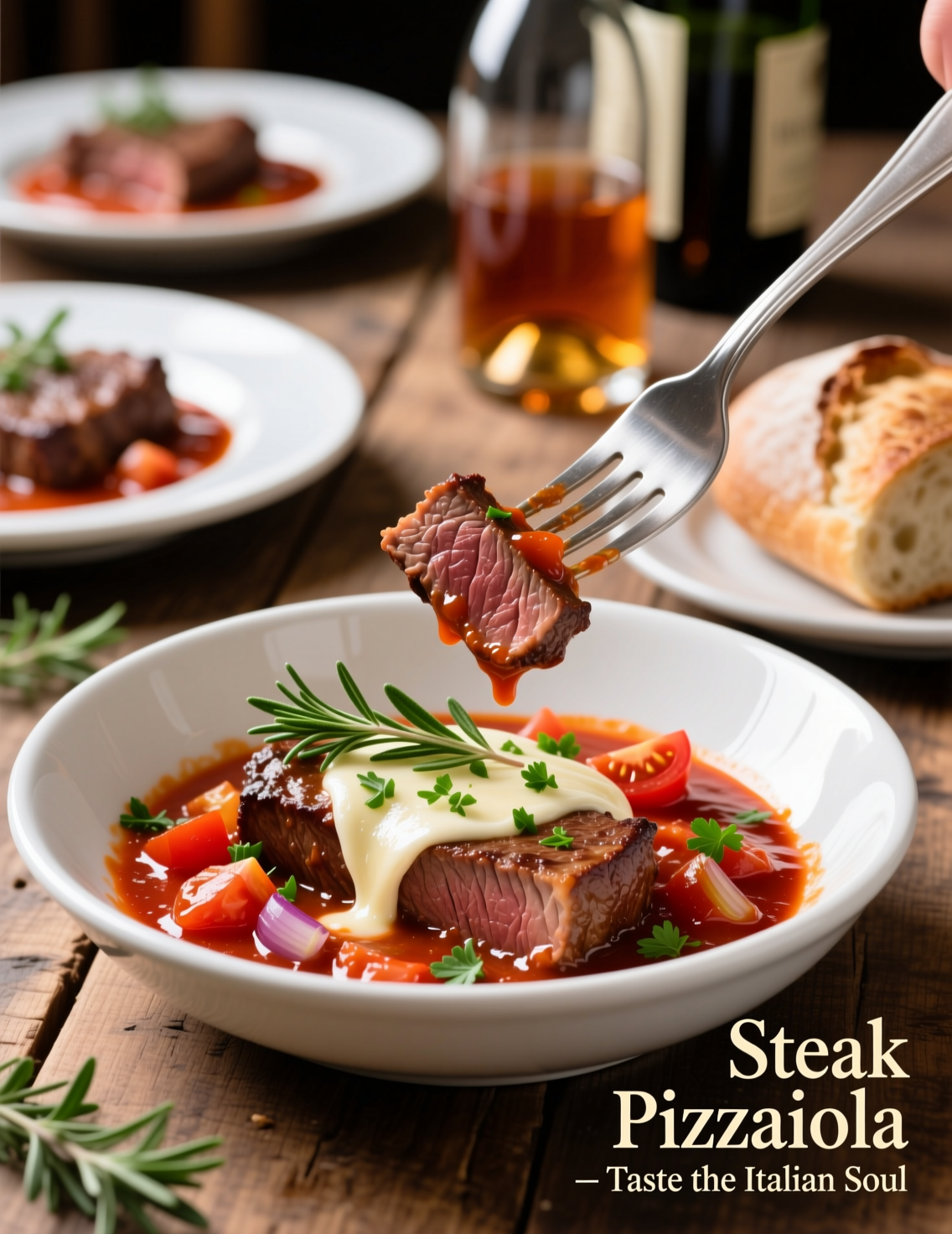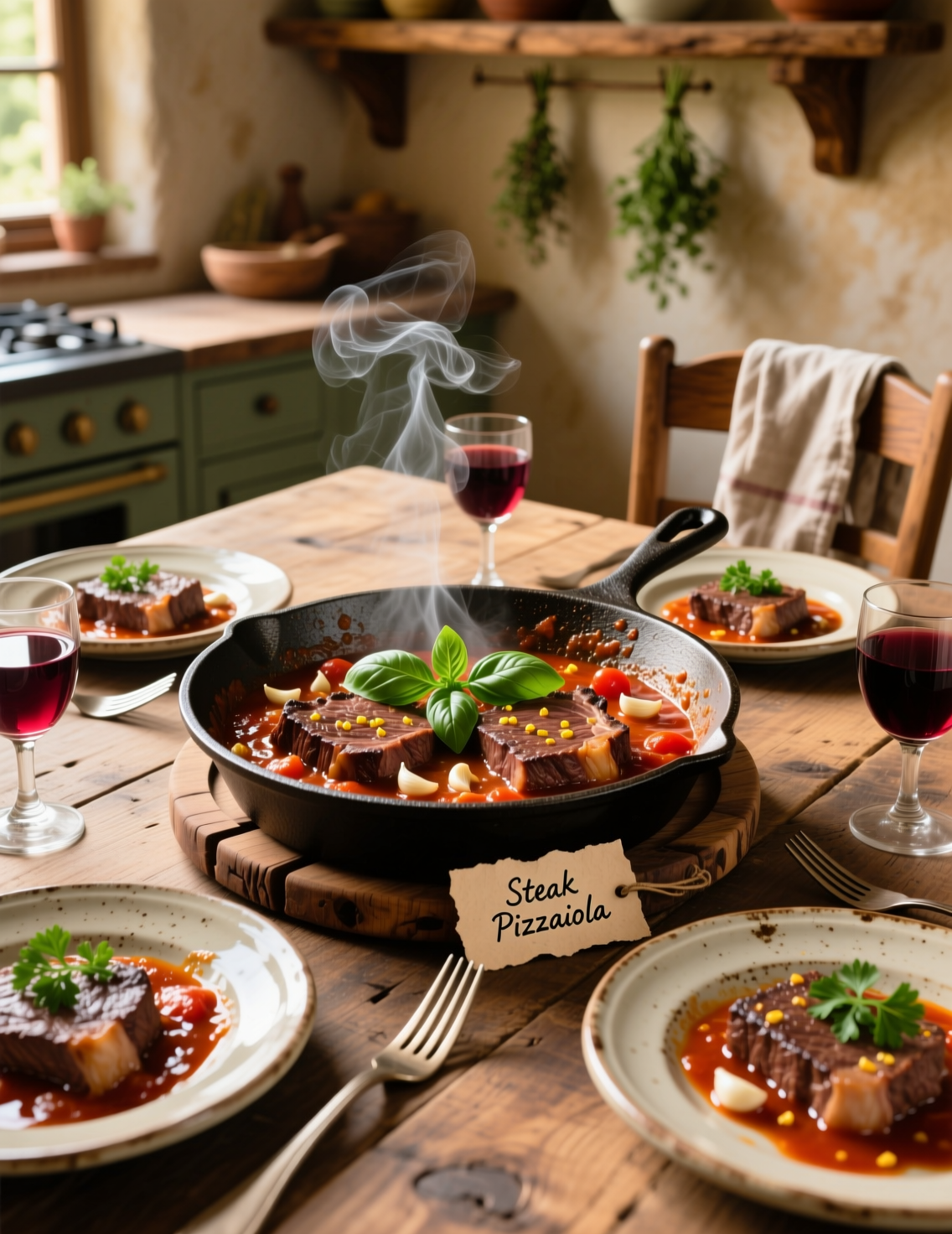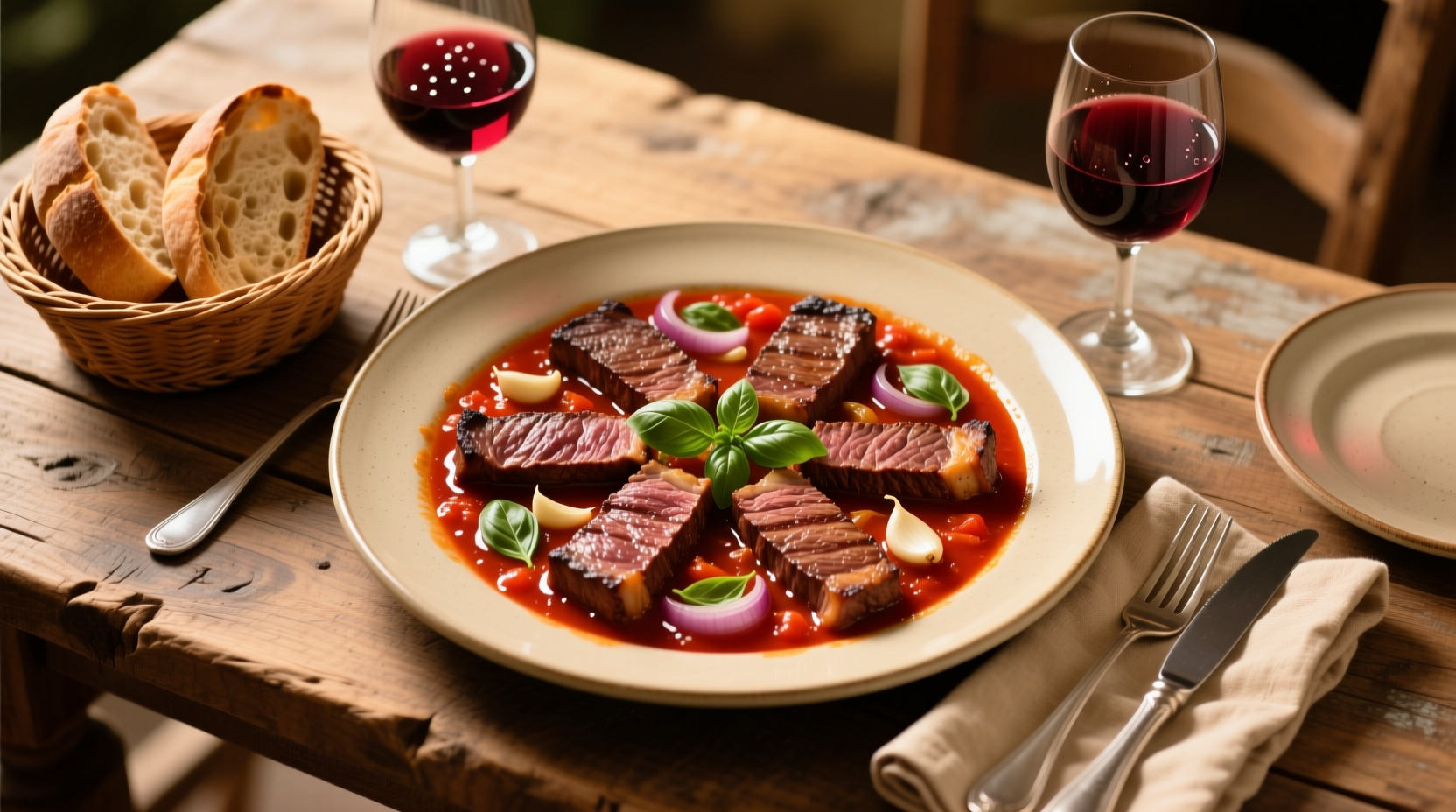There’s something about steak cooked in a pool of bubbling tomatoes, garlic, and herbs that hits harder than most. Steak Pizzaiola isn’t just Italian comfort food—it’s culinary storytelling on a plate. What began as a Neapolitan worker’s dish has become a staple in trattorias across the globe. Today, we’ll not only walk through a precise recipe for four servings but also dig deep into the why behind every step, the science, and even the mistakes pros quietly avoid.
What Exactly Is Steak Pizzaiola?
Steak Pizzaiola, or carne alla pizzaiola, translates loosely to “meat pizza-style.” The sauce—bright tomato, garlic, oregano, and sometimes olives or capers—mirrors a pizza’s topping, hence the name.
Historians believe pizzaiola originated in Naples, where tougher cuts of beef or veal were braised slowly in tomato sauce. Families stretched meals by spooning the sauce over bread or pasta. It wasn’t just food; it was survival turned delicious.
And here’s the kicker: while home cooks leaned on cheaper cuts, modern kitchens often flip the script, using ribeye or sirloin. Why? Because tenderness marries beautifully with that vibrant sauce, giving the dish a rustic yet elevated edge.
Why This Dish Still Matters
Some recipes fade with time, but pizzaiola hasn’t. Italian restaurants from Rome to New York still list it proudly. It straddles that line between everyday and elegant.
Nutritionists note its balance: lean protein, cooked tomatoes loaded with lycopene, and olive oil rich in heart-friendly fats. A 2023 dietary study out of Italy even pointed to traditional tomato-based meat dishes as cornerstones of Mediterranean longevity. Not bad for what’s basically a steak in marinara.
Chefs love pizzaiola for another reason. It’s forgiving. Overcook a steak? The sauce cushions it. Got a chewy cut? The braise coaxes it into tenderness.
Ingredients That Truly Matter
For 4 servings, the balance has to be spot-on. The sauce isn’t just a backdrop—it’s the whole orchestra.
- 4 steaks (sirloin, ribeye, or even chuck, about 7–8 oz each)
- 3 tablespoons extra virgin olive oil
- 1 medium onion, finely sliced
- 4 cloves garlic, smashed, not minced
- 1 can (28 oz) whole San Marzano tomatoes, crushed by hand
- 1 tablespoon tomato paste (for depth, not sweetness)
- 1 teaspoon dried oregano (or 2 teaspoons fresh leaves)
- ½ teaspoon red chili flakes (optional, but Naples would approve)
- A few sprigs of fresh basil
- Salt and freshly cracked black pepper
- Optional: ½ cup sliced black olives or 1 tablespoon capers
- Crusty bread or al dente spaghetti for serving

The Cooking Process
Cooking pizzaiola isn’t about tossing ingredients in a pot and hoping for magic. Each step builds flavor like bricks in a wall. Skip one, and the whole thing feels hollow.
Step 1: Season the Steaks Right
Pat the steaks dry. Sprinkle salt generously and let them sit for 20 minutes. This isn’t just seasoning—it’s science. Salt draws out moisture, dissolves on the surface, then reabsorbs into the meat. The result? Better browning, deeper flavor.
Step 2: Sear, Don’t Steam
Heat a heavy skillet until it’s nearly smoking. Add olive oil. Lay steaks down, listening for that aggressive sizzle. Give them 2 minutes per side just to get a crust. Don’t try cooking them through yet—that’s the sauce’s job later.
This initial sear triggers the Maillard reaction, that magical browning dance between amino acids and sugars. It’s what makes grilled steak taste grilled steak. Without it, pizzaiola tastes flat.
Step 3: Build the Base
In the same pan, toss onions and garlic. Let them sweat until translucent but not burnt. Add tomato paste and cook it out for a minute. Professionals never skip this—it caramelizes and removes raw tin flavor.
Now add crushed tomatoes, oregano, chili flakes. Stir. Bring to a simmer. Already the kitchen smells like Naples in August.
Step 4: Unite Meat and Sauce
Nestle the steaks back into the sauce. Reduce the heat. Cover partly and let it simmer for 20–25 minutes. The timing depends on the cut. Sirloin cooks faster, chuck needs longer.
This slow simmer coaxes the juices from the meat into the sauce, blending everything into one coherent dish. The line between sauce and steak blurs. That’s the soul of pizzaiola.
Step 5: Finishing Touches
Toss in basil at the very end. Maybe olives or capers if you’re going bold. Adjust salt and pepper. Taste—always taste.
Serve immediately with bread to mop or spaghetti to cradle the sauce. A steak knife will feel silly because the meat should cut with a fork.
Expert-Level Insights
Chefs debate the cut endlessly. Ribeye offers flavor from marbling, while sirloin delivers balance. Traditionalists swear by flank or chuck, claiming the sauce makes them tender. The truth? Each has its place. A Michelin-level kitchen might splurge on ribeye, but a Neapolitan grandmother would never waste that money.
Another detail: San Marzano tomatoes. They aren’t marketing fluff. Their lower acidity and firm flesh create a sweeter, silkier sauce. But real ones, grown in Campania’s volcanic soil, carry EU certification. Many “San Marzano” cans in the U.S. are imitations. Professionals know the difference on taste alone.
Common Mistakes to Avoid
Overcooking the steak is mistake number one. Remember, the sauce is simmering. A rare steak will hit medium or medium-well by the end.
Adding too much sugar to the sauce is another sin. If tomatoes are balanced, no sugar’s needed. At most, a pinch if the acidity bites too hard.
And don’t drown the dish in herbs. Pizzaiola isn’t an herb garden. Oregano and basil are enough.
Pairings That Elevate the Dish
Wine pairing? A young Chianti Classico works wonders, its acidity slicing through the sauce. Or try a Nero d’Avola if you want something bolder.
For sides, roasted potatoes hold up better than mashed. Bitter greens like rapini balance the richness. A fennel salad, thinly shaved with lemon and olive oil, cleans the palate between bites.
The Science Behind Tomato Sauces and Meat
A fascinating detail: lycopene, the antioxidant in tomatoes, becomes more bioavailable when cooked with fat. Olive oil and slow simmering literally make the sauce healthier.
Also, acidic tomatoes help tenderize meat proteins. This is why even tougher cuts soften in pizzaiola. It’s culinary chemistry working quietly in the background.
Modern Takes on Pizzaiola
Contemporary chefs sometimes swap beef for chicken or pork chops. Some even go plant-based, braising seitan in the same sauce. In New York, one chef plated pizzaiola with roasted eggplant “steaks,” drawing vegetarians into the tradition.
Sous vide fans have taken it further. They cook steak separately to a precise temperature, then finish it quickly in the sauce. This ensures perfect doneness without guessing. Purists might scoff, but diners rarely complain.

FAQs Professionals Get Asked
Can pizzaiola be prepped ahead?
Absolutely. The sauce can be made 2–3 days in advance. Reheat and add fresh-seared steak just before serving.
What’s the best way to store leftovers?
Airtight container, refrigerated, up to 3 days. The sauce gets richer overnight.
Can it be frozen?
Yes, though fresh basil loses its perfume. Add herbs after reheating.
Why does my sauce taste metallic?
Likely the can. Buy whole tomatoes in BPA-free cans or glass jars. Always cook tomato paste properly.
What cut of steak works best for pizzaiola?
Ribeye for richness, sirloin for balance, or flank/chuck if slow-simmered.
Can I make the sauce ahead of time?
Yes, up to 2–3 days in advance, then reheat and add the steak fresh.
Do I need San Marzano tomatoes?
They’re best for flavor, but good-quality canned tomatoes will still work.
How long should the steak simmer in the sauce?
About 20–25 minutes, depending on the cut and thickness.
Can steak pizzaiola be frozen?
Yes, though add fresh basil after reheating for best flavor.
What’s the best wine pairing?
A young Chianti Classico or a bold Nero d’Avola pairs beautifully.
Why did my sauce taste metallic?
It’s usually from cheap cans—opt for BPA-free cans or glass jars.
Should sugar be added to the sauce?
Only a pinch if the tomatoes are overly acidic.
What sides go well with pizzaiola?
Roasted potatoes, bitter greens, or a crisp fennel salad.
Can I use chicken or pork instead of beef?
Yes, chicken or pork chops also work well with pizzaiola sauce.
Conclusion – Why You Should Cook This Dish Now
Steak Pizzaiola is proof that the best dishes don’t need complexity. It thrives on balance, technique, and a respect for ingredients. Every detail matters—the sear, the tomatoes, the patient simmer.
For professionals, it’s a dish that teaches restraint. For home cooks, it’s a recipe that feels bigger than the sum of its parts. And for anyone at the table, it’s simply food that makes you lean back, sigh, and wonder how four ingredients can sing so loud.
So grab that heavy pan, crack open a can of real San Marzanos, and let steak pizzaiola remind you why Italian cooking still reigns supreme.

Mariana is a passionate home cook who creates delicious, easy-to-follow recipes for busy people. From energizing breakfasts to satisfying dinners and indulgent desserts, her dishes are designed to fuel both your body and hustle.
When she’s not in the kitchen, she’s exploring new flavors and dreaming up her next recipe to share with the Foodie Hustle community.

